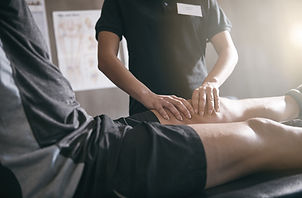18 Stillwater Rd
Blairstown NJ 07825
908-362-8767
Dr. Sandy Giacobbe
Chiropractic Physician

Arthritis and Joint Pain Relief
Can your diet affect joint pain?
Many people experience joint pain and arthritis at some point in their lives. It can be as a result of an acute injury, such as an ankle sprain, knee sprain, or rotator cuff tear. Joint pain may also accompany varying types of joint inflammation, including osteoarthritis (degenerative joint disease), rheumatoid arthritis, psoriatic arthritis, and joint inflammation secondary to lupus erythematosus and irritable bowel syndrome. Of the numerous causes of joint inflammation, osteoarthritis is by far the most common, frequently affecting the lower back, neck, hips, knees, shoulders, and wrists. Many factors are associated with the development of osteoarthritis, including overuse, too little use, faulty biomechanics, and overall lack of exercise. Joint pain related to osteoarthritis may be improved and ameliorated to a certain extent by engaging in a comprehensive program of restoring more efficient biomechanics, targeted exercise, and healthy nutrition.
Diet is frequently implicated in various systemic inflammatory disorders and, in consequence, various joint inflammatory conditions. For example, celiac disease, a chronic inflammatory disorder, is often associated with gluten insensitivity or gluten intolerance. Malabsorption syndrome and leaky gut syndrome, both of which may be associated with joint inflammation, may be associated with gluten insensitivity or gluten intolerance. The inclusion of nutritional supplementation such as probiotics and prebiotics is helpful in the overall management of malabsorption syndrome and leaky gut syndrome. As well, instituting a gluten-free diet may be of assistance in managing gluten sensitivity, gluten intolerance, and conditions such as celiac disease.
Additionally, sugar, refined carbohydrates, saturated fats, monosodium glutamate, and alcohol are known causes and potentiators of joint inflammation. For certain individuals, dairy products, eggs, tomatoes, nuts, and coffee may exacerbate existing joint inflammation. In contrast, for most people, diets containing at least five servings of fresh fruits and vegetables daily help prevent the development of joint inflammation and help reduce inflammatory processes and thus ameliorate a primary cause of joint pain.
Exercise helps to improve joint range of motion, strengthen supporting muscle groups, and increase the resiliency and flexibility of local soft tissues such as tendons and ligaments. Optimally, exercise is done five days a week for at least 30 minutes each day. Beneficial forms of exercise include walking, swimming, bicycling, yoga, and strength training. If you haven't exercised in some time, start slowly and gently, building up your capacity and stamina.
Regular chiropractic care plays a key role in the effective management of joint pain. By detecting and correcting sources of spinal nerve irritation and nerve interference, regular chiropractic care helps to optimize the functioning of your entire physiology. Potential causes of joint pain in the neck, mid back, and lower back are addressed directly, and joint pain in other locations is benefited by more normalized communication between those sites and the nerve system as a whole. In this way, regular chiropractic care helps improve the long-term overall health and well-being of you and your family.



How Chiropractic Care can help with Arthritis and Joint Pain
At Stillwater Health and Wellness, we use a combination of techniques depending on the status and severity of your Joint Pain or Arthritis:
• Adjustments - Manual adjustments and alignments may result in better joint and nerve function, which actively contribute to the mobility in the area of your injury.
• Decompression Techniques – Methods involve stretching out certain parts of the body in order to separate the joint surfaces. Since many stress ailments occur around joints or related areas, this can be used to great effect. It may be combined with ongoing stretching at home in order to help the injured area and restore range of motion.
• Percussion massage - Soft tissue massages help loosen tight muscles, reduce inflammation, improve circulation and reduce pain.
• Low Level Laser Therapy - has been shown in clinical trials to reduce pain by more than 70% and decrease inflammation by targeting the cells and tissues, improving circulation to the arthritic area.
• Home Exercises - We will make recommendations for specific at home exercises to rehabilitate the area involved.
• Nutritional Supplements - We recommend supplements that help play a role in recovery from pain and inflammation. For information contact us at 908-362-8767.
